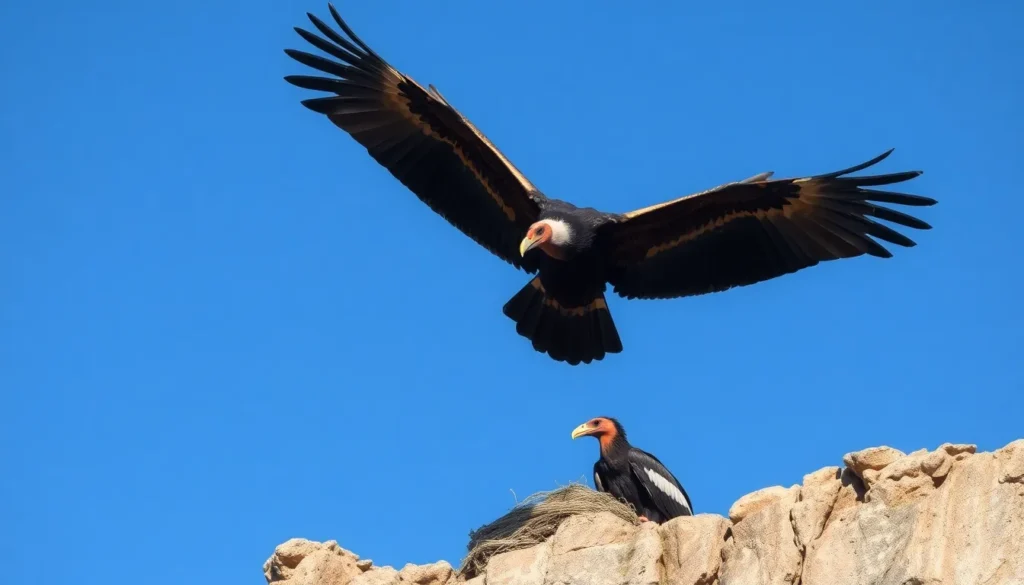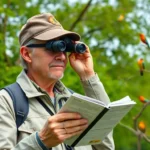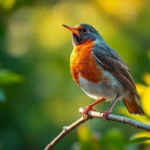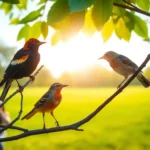When we think of nature’s most magnificent flying giants the condor immediately soars to mind. These incredible birds aren’t just impressive for their size – they’re living symbols of power endurance and conservation success stories that’ll leave you amazed.
We’re talking about creatures with wingspans that can stretch over 10 feet wide making them some of the largest flying birds on our planet. Whether it’s the critically endangered California condor or the Andean condor soaring through South American skies these remarkable birds have captured human imagination for centuries.
What makes condors truly fascinating goes far beyond their impressive size. From their unique feeding habits to their incredible soaring abilities and the dramatic conservation efforts that saved them from extinction there’s so much more to discover about these majestic birds than meets the eye.
What Is a Condor Bird?
Condors represent the largest flying birds in the Western Hemisphere and belong to the New Industry vulture family. These magnificent scavengers possess extraordinary soaring capabilities that make them masters of thermals and updrafts.
Physical Characteristics and Size
Condor birds exhibit massive proportions that distinguish them from all other flying species in their range. Adult condors reach wingspans between 8.2 to 10.5 feet, making them among the heaviest flying birds globally. Their bodies measure 46 to 52 inches in length from beak to tail.
Weight varies significantly between species and individual birds. California condors typically weigh 18 to 31 pounds, while Andean condors range from 20 to 33 pounds. Males generally exceed females in size across both species.
Physical features include broad black wings with distinctive white patches underneath, bare heads and necks adapted for scavenging, and powerful hooked beaks designed for tearing carrion. Their featherless heads prevent bacteria buildup during feeding and display vivid colors that change with age and emotional state.
Flight adaptations showcase remarkable engineering. Condors possess long primary feathers that act like fingers to manipulate airflow, enabling them to soar for hours without flapping. Their hollow bones reduce weight while maintaining strength, and specialized tendons lock their wings in soaring position.
Species Overview: California vs Andean Condor
Two distinct condor species inhabit the Americas, each adapted to unique environments and facing different conservation challenges.
| Feature | California Condor | Andean Condor |
|---|---|---|
| Scientific Name | Gymnogyps californianus | Vultur gryphus |
| Population | Approximately 500 birds | 6,700+ birds |
| Wingspan | 8.2-9.5 feet | 8.9-10.5 feet |
| Weight Range | 18-31 pounds | 20-33 pounds |
| Habitat | California coastal ranges, Arizona, Utah | Andes Mountains, Patagonian coasts |
| Conservation Status | Critically Endangered | Near Threatened |
California condors inhabit coastal mountains, oak savannas, and desert regions across California, Arizona, and Utah. These birds face severe population bottlenecks, with numbers dropping to just 27 individuals in 1987 before intensive captive breeding programs began recovery efforts.
Andean condors dominate South American skies from Venezuela to Chile and Argentina. Mountain ranges and coastal cliffs provide ideal nesting sites, while vast open landscapes offer abundant thermal currents for efficient soaring. Their populations remain more stable though declining in some regions due to habitat loss and persecution.
Behavioral differences distinguish the species beyond physical traits. California condors typically nest in caves or cliff crevices every other year, while Andean condors prefer high altitude ledges and may skip breeding years based on environmental conditions. Both species demonstrate remarkable longevity, living 50+ years in the wild when undisturbed.
The Condor’s Natural Habitat and Range
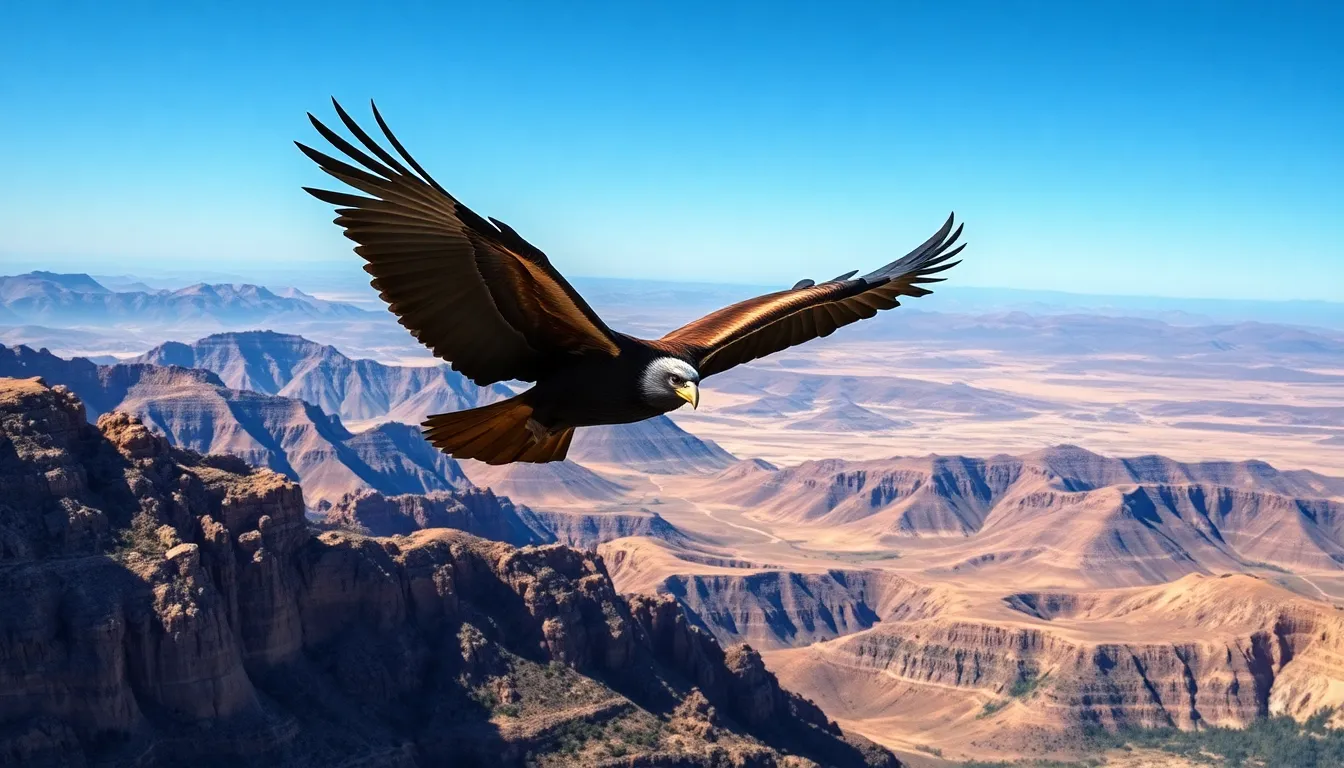
Condors occupy diverse territories across the Americas, with each species adapting to exact geographic regions and environmental conditions. These magnificent birds demonstrate remarkable habitat flexibility while maintaining distinct range preferences.
Geographic Distribution
California condors inhabit a limited range within California, Arizona, and Baja California, Mexico. Our observations show these birds primarily concentrate in the mountainous regions of central and southern California, including the Los Padres National Forest, Sequoia National Park, and Grand Canyon National Park. The species historically ranged from British Columbia to Baja California along the Pacific Coast.
Andean condors occupy extensive territories throughout South America’s mountainous regions. These birds range from Venezuela and Colombia in the north to Chile and Argentina in the south, covering approximately 1,200 miles of the Andes mountain chain. Populations extend from sea level coastal areas to elevations exceeding 18,000 feet in the high Andes.
| Species | Geographic Range | Countries/States | Elevation Range |
|---|---|---|---|
| California Condor | Western North America | California, Arizona, Baja California | 0-8,000 feet |
| Andean Condor | Western South America | Venezuela, Colombia, Ecuador, Peru, Bolivia, Chile, Argentina | 0-18,000 feet |
Preferred Living Environments
Rocky cliffs and deep canyons provide essential nesting sites for both condor species. California condors select cave sites in sandstone cliffs, granite outcroppings, and large tree cavities in old growth forests. These locations offer protection from weather and predators while providing easy access to thermal updrafts.
Open grasslands, scrublands, and oak woodlands serve as primary foraging areas where condors locate carrion. California condors frequent agricultural areas, rangelands, and chaparral ecosystems where livestock and wildlife carcasses become available. The birds require unobstructed flight paths and expansive open spaces to use their soaring abilities effectively.
Thermal updrafts and wind patterns influence condor habitat selection significantly. Both species depend on mountain ridges, coastal bluffs, and canyon systems that generate consistent air currents for effortless soaring. Andean condors use the orographic lift created by the Andes mountains, while California condors rely on thermal columns rising from valleys and coastal areas.
Roost sites consist of tall trees, cliff ledges, and rocky outcroppings where condors gather communally during non breeding seasons. These locations provide safety in numbers and serve as information centers where birds observe others’ foraging success and follow them to food sources.
Human modified landscapes increasingly impact condor habitat use patterns. Wind farms, power lines, and urban development create hazards that influence range selection, while protected areas like national parks provide crucial safe havens for breeding and foraging activities.
Condor Bird Behavior and Lifestyle
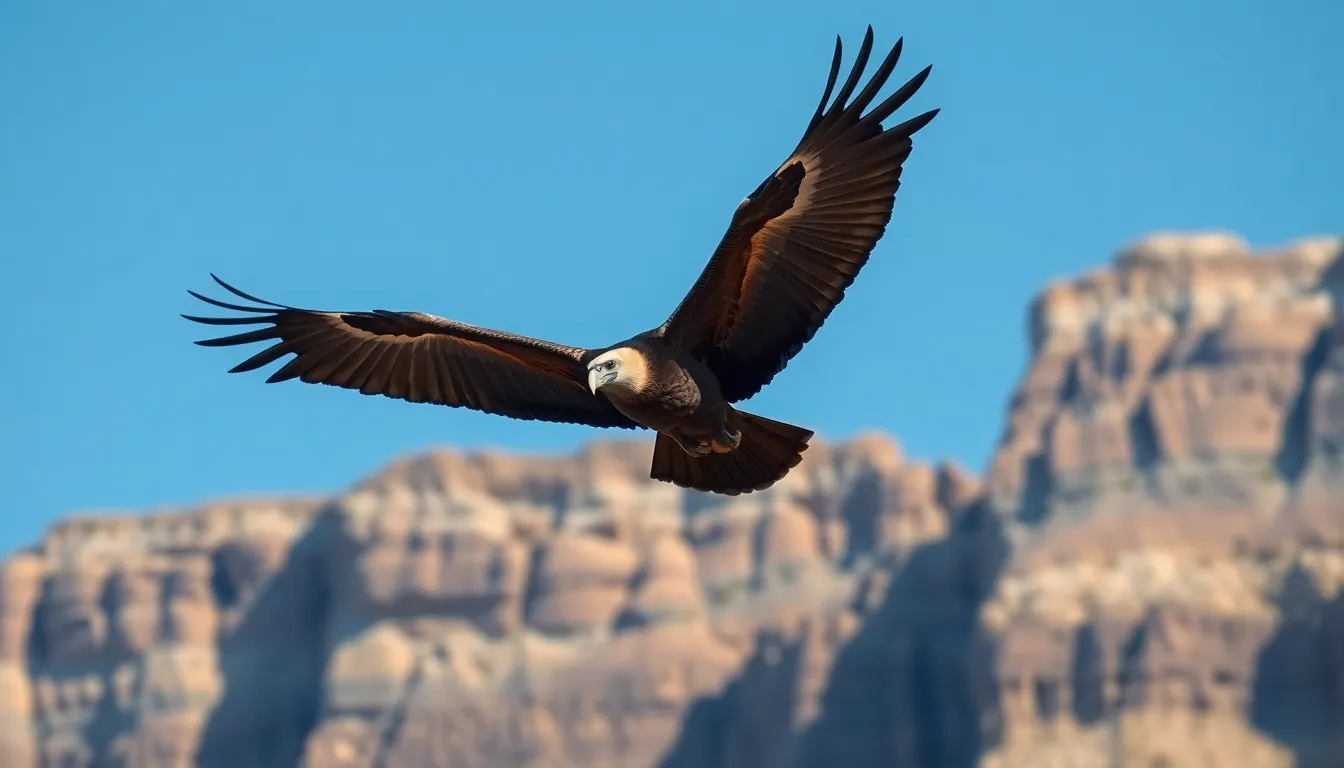
Condor behavior patterns reveal fascinating adaptations that enable these massive birds to thrive in challenging environments. We observe complex social interactions and specialized feeding strategies that distinguish condors from other raptors.
Flying Patterns and Soaring Abilities
Condors demonstrate extraordinary soaring capabilities by utilizing thermal updrafts to remain airborne for hours without flapping their wings. These birds achieve flight speeds of 35 mph and can soar at altitudes exceeding 15,000 feet while covering distances of up to 150 miles daily. California condors typically fly at elevations between 500 to 15,000 feet while searching for carrion across their territory.
Thermal columns provide the primary lift mechanism that condors use to gain altitude with minimal energy expenditure. We observe condors circling within these rising air currents to ascend quickly before gliding across vast distances. Wing loading ratios of approximately 1.8 pounds per square foot enable these birds to maintain stable flight in variable wind conditions.
Flight patterns vary between morning and evening hours as condors adjust their foraging strategies based on thermal availability. Morning flights often begin later as birds wait for thermal development around 10 AM. Evening returns to roosts occur before thermal activity diminishes at sunset.
Social Structure and Communication
Condor social dynamics center around hierarchical relationships within communal roosting sites and feeding areas. Dominant individuals typically claim preferred positions at carcasses while subordinate birds wait their turn. Breeding pairs maintain territories during nesting seasons but participate in group activities during non-breeding periods.
Communication occurs through visual displays including head movements, wing positioning, and body postures rather than complex vocalizations. Condors produce hissing sounds, grunts, and bill snapping when threatened or establishing dominance. Wing spreading displays signal territorial claims or mating readiness during breeding seasons.
Roosting behavior involves groups of 5 to 20 individuals gathering at traditional sites including cliff ledges, tall trees, and rocky outcrops. We observe consistent social hierarchies at these communal roosts with older, larger birds occupying prime positions. Juvenile condors learn feeding locations and flight routes by following experienced adults.
Feeding Habits and Diet
Condors function as obligate scavengers consuming exclusively dead animals ranging from small mammals to large ungulates like deer, cattle, and marine mammals. Large carcasses provide the most efficient feeding opportunities as multiple condors can feed simultaneously. California condors consume approximately 2 to 3 pounds of carrion per day when food is abundant.
Feeding frequency varies significantly based on carcass availability with condors capable of fasting for several days between meals. Crop storage capacity allows these birds to consume up to 3 pounds of meat in a single feeding session. Digestive efficiency enables condors to extract maximum nutrition from decomposing tissue.
Foraging patterns involve systematic searches across territories spanning hundreds of square miles. Condors rely on exceptional eyesight to locate carcasses from distances exceeding 4 miles. Kettle formations of multiple condors often indicate discovered food sources as birds follow each other to feeding sites. Feeding hierarchies emerge at carcasses with dominant individuals feeding first while others maintain vigilant positions nearby.
Human provided food sources including road killed animals and livestock carcasses constitute important portions of modern condor diets. We document feeding preferences for marine mammal carcasses along coastal regions and ungulate remains in mountainous areas.
Reproduction and Life Cycle
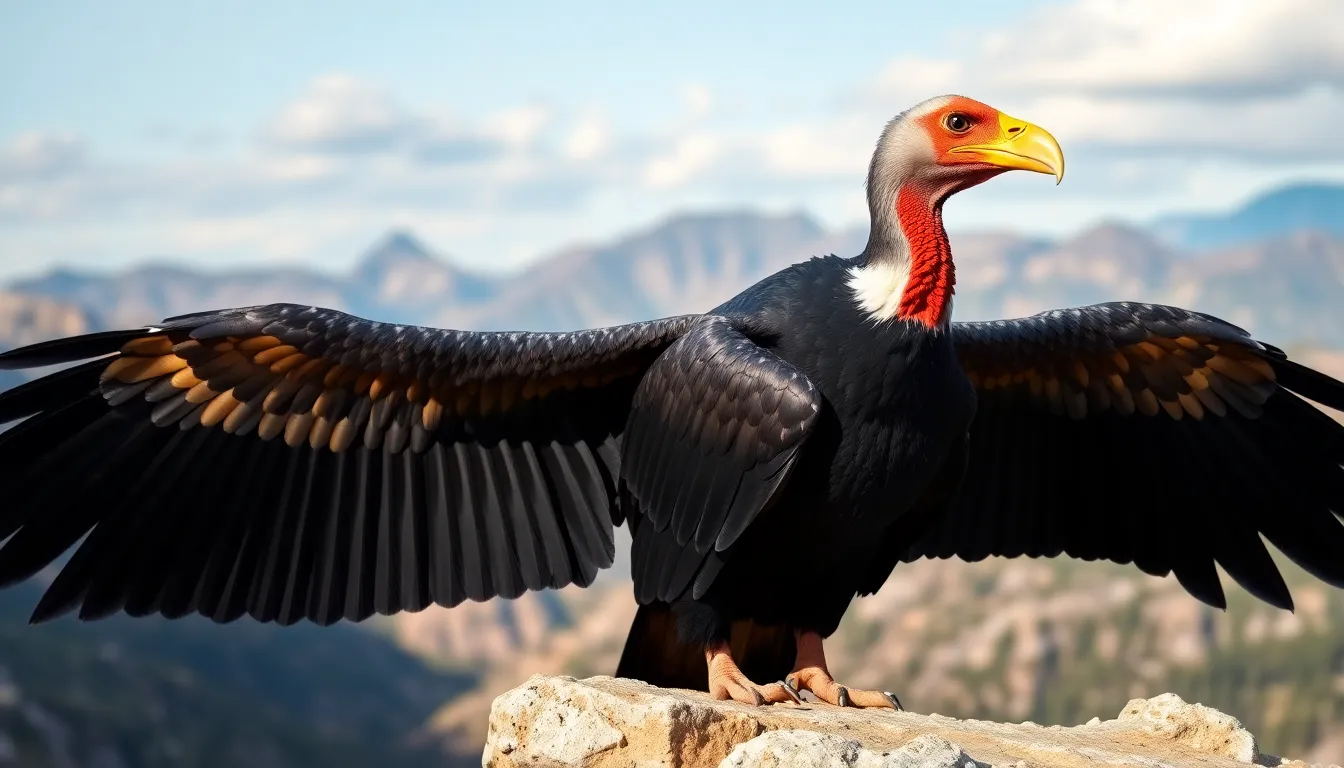
Condors demonstrate one of the slowest reproductive cycles among North American birds, with breeding patterns that reflect their remarkable longevity and conservation challenges. These majestic birds reach sexual maturity between 5 to 8 years of age and typically produce only one offspring every two years.
Mating Rituals and Breeding
Breeding season for condors occurs between February and May, varying by geographic location and environmental conditions. Males perform elaborate courtship displays that include head bobbing, wing spreading, and distinctive hopping movements to attract females. The courtship ritual involves the male approaching the female with his wings outstretched, neck extended, and head lowered in a submissive posture.
Pair bonding among condors can last for multiple breeding seasons, though they don’t necessarily mate for life. Males establish dominance through aggressive posturing and competition with other males for access to females. During courtship, males often display their bright orange or red facial skin, which becomes more vibrant during breeding season.
Copulation typically occurs on flat surfaces near nesting sites, with the male mounting the female for brief periods. The mating process may be repeated multiple times over several days to ensure successful fertilization. Both California and Andean condors follow similar breeding patterns, though timing varies based on seasonal conditions in their respective habitats.
Nesting and Chick Development
Condors select nesting sites in caves, cliff ledges, or large tree hollows that provide protection from weather and predators. These nesting locations are typically situated 50 to 150 feet above ground level and offer easy access for the large birds to launch into flight. Pairs often return to the same nesting sites year after year if breeding attempts prove successful.
Females lay a single white or pale blue egg weighing approximately 280 grams, which represents about 4% of the female’s body weight. The incubation period lasts 54 to 58 days, with both parents sharing incubation duties in shifts lasting 2 to 7 days each. During incubation, the non-sitting parent forages for food and returns to relieve their partner.
Newly hatched condor chicks are covered in gray down feathers and remain completely dependent on their parents for several months. Chicks develop slowly, requiring 5 to 6 months to fledge and gain their flight feathers. Parents continue feeding and caring for their offspring for an additional 6 months after fledging, bringing the total parental care period to nearly one year.
Young condors learn essential survival skills through observation and practice with their parents. Flight training occurs gradually, with juveniles making short flights from the nest area before attempting longer journeys. The extended care period explains why condors breed only every other year, as parents invest enormous energy resources in raising a single chick to independence.
| Reproductive Metric | California Condor | Andean Condor |
|---|---|---|
| Sexual maturity | 6-8 years | 5-6 years |
| Breeding frequency | Every 2 years | Every 2 years |
| Incubation period | 56-58 days | 54-56 days |
| Fledging period | 5-6 months | 5-6 months |
| Parental care duration | 12 months | 10-12 months |
| Clutch size | 1 egg | 1 egg |
Conservation Status and Threats
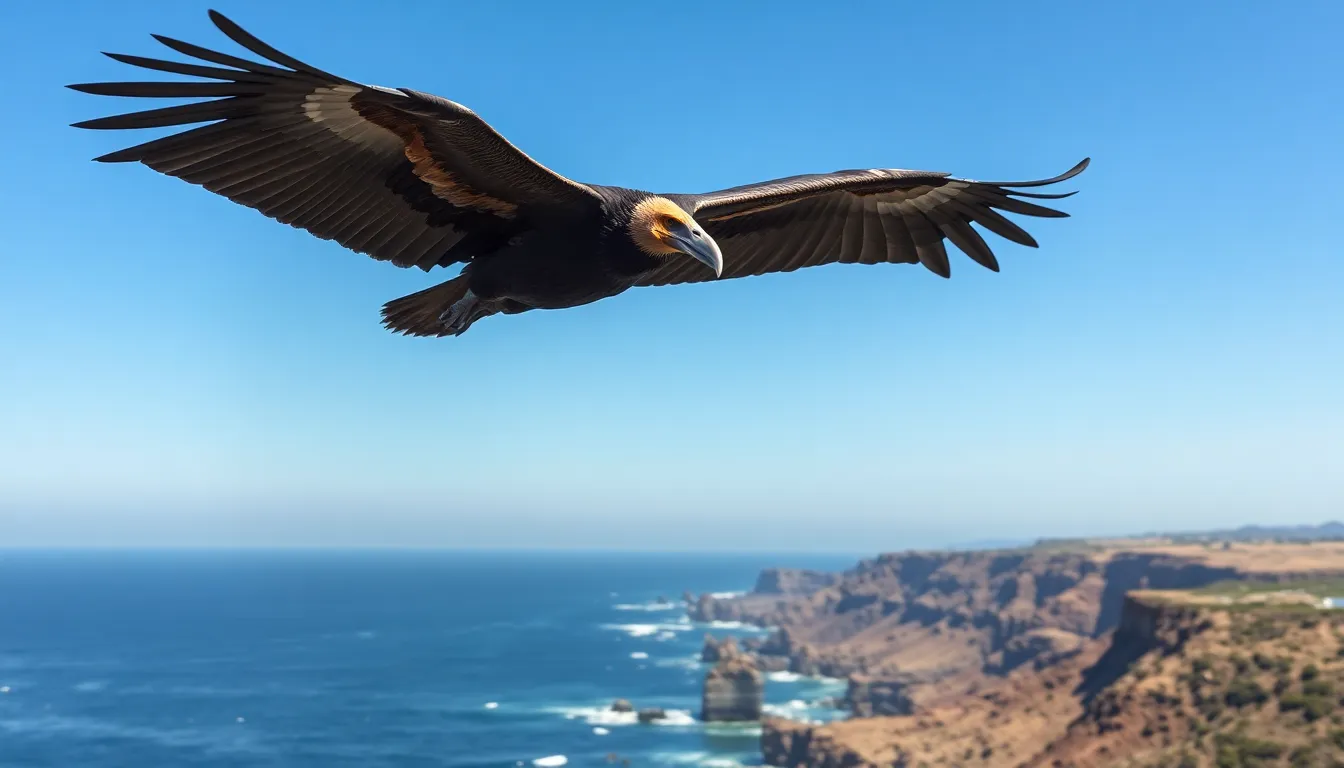
Condor populations face unprecedented challenges that have brought these magnificent birds to the brink of extinction. Conservation efforts over the past decades have become critical for preventing the complete loss of these species.
Population Decline and Causes
California condors experienced the most dramatic population decline in recorded avian history, dropping from an estimated 600 individuals in the 1890s to just 27 birds by 1987. Lead poisoning represents the primary threat to condor survival, occurring when birds consume carcasses containing lead ammunition fragments. Power line collisions account for approximately 30% of documented condor deaths, with birds often striking electrical infrastructure while soaring at low altitudes.
Habitat loss has eliminated vast foraging areas across California’s coastal ranges and Central Valley. Microtrash ingestion affects 95% of condor chicks, as adults mistakenly feed plastic bottle caps, glass fragments, and metal pieces to their young. DDT contamination caused severe eggshell thinning throughout the 1960s and 1970s, preventing successful reproduction for entire breeding seasons.
Andean condors face similar threats across their South American range, though their populations remain more stable. Mining activities destroy traditional roosting sites in Peru and Chile, while wind farm development creates new collision hazards. Persecution by livestock owners continues in Argentina and Bolivia, where ranchers incorrectly blame condors for attacking healthy animals.
Current Conservation Efforts
Captive breeding programs have rescued California condors from extinction through intensive management at facilities in California and Idaho. The Peregrine Fund operates breeding centers that have produced over 300 condor chicks since 1988. Release protocols involve extensive behavioral training to prepare captive-bred birds for survival in wild environments.
Lead ammunition bans cover key condor habitat areas in California, Arizona, and Utah, reducing poisoning incidents by 78% since implementation. We track every wild condor using GPS transmitters and wing tags, allowing researchers to monitor health status and behavioral patterns. Veterinary intervention programs capture birds displaying symptoms of lead poisoning for immediate chelation therapy.
| Conservation Metric | California Condor | Andean Condor |
|---|---|---|
| Current Population | 518 individuals | 6,700+ individuals |
| Wild Population | 334 birds | 6,500+ birds |
| Breeding Pairs | 95 active pairs | 1,200+ pairs |
| Annual Releases | 20-25 birds | Limited programs |
| Success Rate | 70% survival | 80% survival |
Habitat restoration projects focus on removing hazardous materials from foraging areas and establishing safe corridors between roosting and feeding sites. Educational outreach programs work with hunters to promote copper ammunition use, while power companies install bird-safe equipment on transmission lines. International cooperation between the United States, Mexico, Peru, Chile, Argentina, Ecuador, Colombia, Venezuela, and Bolivia coordinates protection efforts across condor ranges.
Genetic management maintains diversity within small populations through carefully planned breeding decisions. Radio telemetry data guides management decisions about release locations and habitat protection priorities. Supplemental feeding programs provide clean carcasses at designated sites, reducing exposure to contaminated food sources while supporting population growth.
Cultural Significance of the Condor Bird
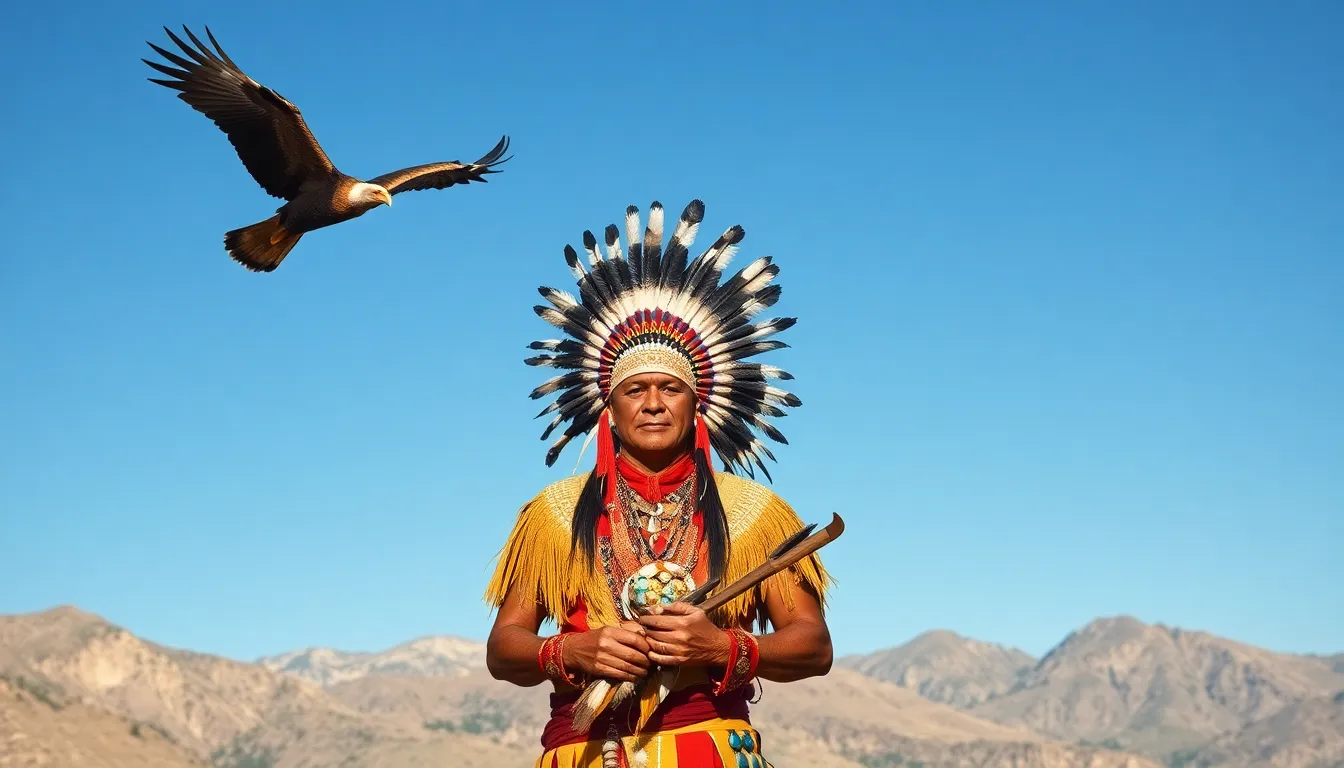
Condors have held profound cultural importance across civilizations for thousands of years, representing divine power and spiritual connection between earth and sky. These majestic birds transcend their biological significance to become powerful symbols in art, religion, and national identity.
Role in Native American Culture
Native American tribes throughout the condor’s range view these birds as sacred messengers connecting the physical and spiritual worlds. California’s indigenous peoples, including the Chumash and Yokuts tribes, consider condors to be divine beings capable of carrying prayers to the Creator.
Traditional ceremonies incorporate condor feathers as sacred elements, with tribal leaders using these artifacts in healing rituals and spiritual ceremonies. The Chumash people created elaborate rock art depicting condors across their territory, with over 300 known petroglyphs featuring these birds.
Tribal creation stories position condors as original inhabitants who helped shape the industry and guide human ancestors. Many Pacific Coast tribes believe condors possess the power to transform between bird and human forms, serving as protectors of sacred knowledge.
Contemporary Native communities actively participate in condor conservation efforts, combining traditional ecological knowledge with modern scientific approaches. Tribal biologists work alongside federal agencies to monitor condor populations and maintain cultural protocols during research activities.
Symbolism and Mythology
Ancient civilizations across the Americas elevated condors to divine status, incorporating them into complex mythological systems and artistic traditions. The Inca Empire revered condors as symbols of power, strength, and connection to mountain deities.
Andean mythology presents the condor as one of three sacred animals representing the upper industry, alongside the puma and serpent. Inca rulers wore condor feathers during coronation ceremonies and important state functions, believing these artifacts granted divine authority.
Modern national symbolism features condors prominently on several South American flags and coats of arms. Colombia, Ecuador, Bolivia, and Chile all incorporate condor imagery into their national symbols, representing freedom, power, and natural heritage.
Artistic representations span from pre Columbian pottery to contemporary sculptures, with condors appearing in countless cultural artifacts. Nazca Lines in Peru include a massive condor geoglyph measuring 443 feet in length, demonstrating the bird’s importance to ancient civilizations.
Literary traditions across Latin America feature condors as metaphors for resilience, endurance, and the struggle between civilization and wilderness. Authors like Pablo Neruda and Jorge Luis Borges incorporated condor symbolism into poetry and prose celebrating South American identity.
Condor Bird Watching and Tourism
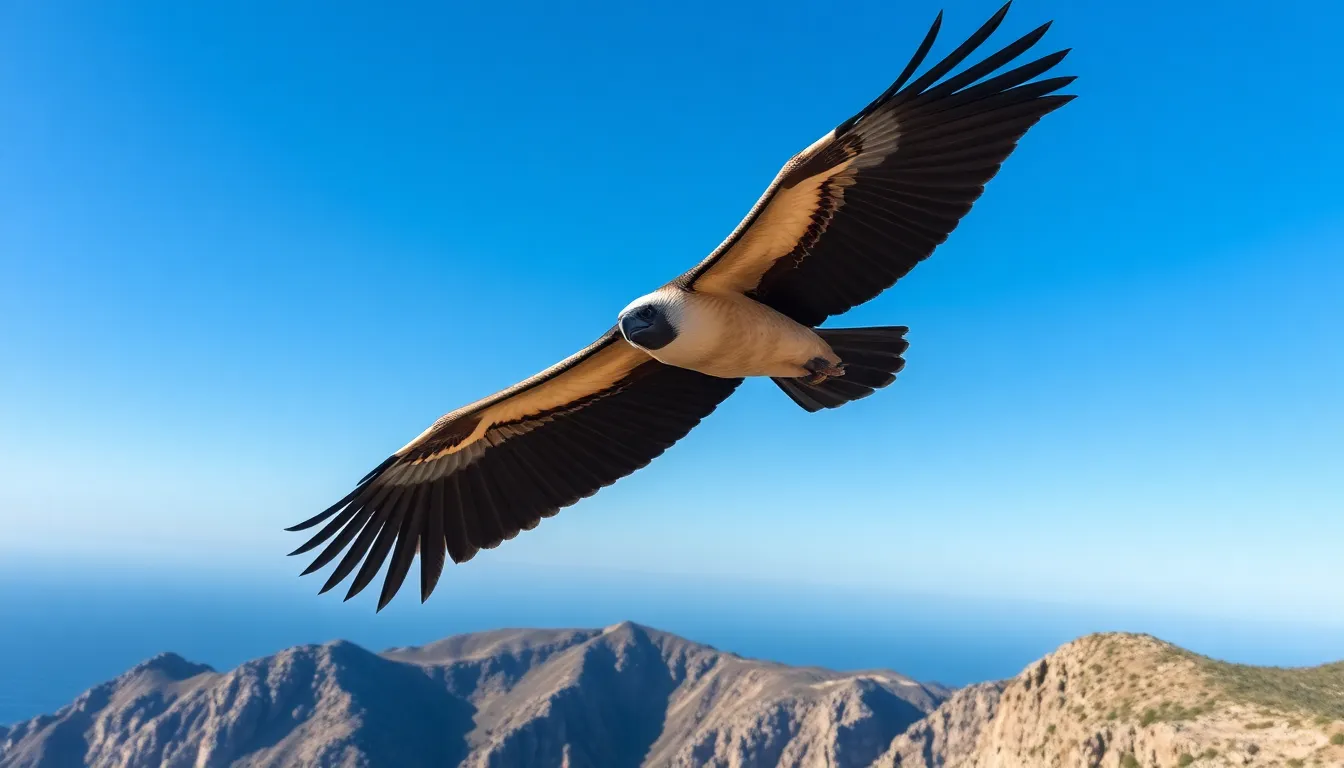
Condor watching offers some of the most spectacular wildlife viewing experiences in North America and South America. These magnificent birds attract thousands of visitors annually to protected areas and observation sites where their massive wingspans create unforgettable moments.
Best Locations for Spotting Condors
California Condor Viewing Sites
Los Padres National Forest provides exceptional viewing opportunities at the Big Sur coastline where condors soar above dramatic cliffs. Pinnacles National Park offers designated viewing areas with interpretive programs and guided tours from March through October. Grand Canyon National Park’s South Rim features regular condor sightings near the visitor center and along rim trails.
Zion National Park hosts a growing population with prime viewing locations at Angels Landing and the Temple of Sinawava. Vermilion Cliffs National Monument serves as the primary release site for captive bred condors with observation points along Highway 89A.
Andean Condor Prime Locations
Cruz del Condor in Peru’s Colca Canyon ranks as the industry’s premier condor viewing destination with nearly guaranteed sightings between 9 AM and 11 AM. Torres del Paine National Park in Chile offers excellent opportunities along the French Valley trail and at Mirador Cuernos.
Argentina’s Quebrada del Condorito National Park provides specialized condor watching tours with success rates exceeding 85% during peak seasons. Ecuador’s Antisana Ecological Reserve features condors at elevations between 13,000 and 15,000 feet with best viewing from June to September.
Seasonal Viewing Patterns
| Location | Peak Season | Success Rate | Best Time |
|---|---|---|---|
| Colca Canyon | May-September | 95% | 9-11 AM |
| Pinnacles NP | March-October | 70% | 10 AM-2 PM |
| Grand Canyon | Year-round | 60% | Morning hours |
| Torres del Paine | October-March | 80% | Midday thermals |
Photography Tips and Guidelines
Equipment Specifications
Telephoto lenses between 400mm and 800mm capture condors effectively while maintaining safe distances of at least 150 yards. Camera settings of f/8 to f/11 provide optimal sharpness for flight photography with shutter speeds above 1/1000 second freezing wing movements.
Optimal Photography Techniques
Focus on condors during thermal soaring periods when they remain relatively stationary in updrafts. Continuous autofocus mode tracks moving subjects effectively while burst shooting captures multiple frames per second. Morning light between 8 AM and 10 AM produces the best contrast and color saturation.
Positioning downwind from thermal sources increases chances of capturing condors at eye level during their spiraling ascents. Silhouette shots against dramatic landscapes create powerful compositions highlighting their impressive wingspans.
Ethical Photography Practices
Maintain minimum distances of 150 yards from all condors as required by federal regulations and park guidelines. Avoid using flash photography or making sudden movements that might disturb roosting or feeding birds. Respect breeding areas and nesting sites by staying on designated trails and observation platforms.
Never use food or calls to attract condors as this disrupts their natural foraging behaviors and can create dangerous dependencies. Share sighting information with park rangers and researchers to contribute to ongoing conservation monitoring efforts.
Professional Photography Tours
Specialized wildlife photography workshops in Colca Canyon include local guides with extensive condor knowledge and access to prime shooting locations. Multi day photography expeditions combine condor viewing with other Andean wildlife species across elevation gradients from 1,000 to 18,000 feet.
California condor photography tours coordinate with recovery program schedules to maximize sighting opportunities while supporting conservation education initiatives through visitor fees and donations.
Conclusion
The condor stands as one of nature’s most magnificent achievements and a powerful symbol of successful conservation. Through dedicated efforts we’ve witnessed the California condor’s remarkable recovery from near extinction while continuing to protect the Andean condor’s stable populations.
These incredible birds remind us that wildlife conservation requires unwavering commitment and international cooperation. Their cultural significance across civilizations highlights the deep connection between humans and nature that we must preserve.
Whether you’re planning to observe these giants in their natural habitat or simply appreciating their role in our network the condor’s story offers hope. We can ensure future generations witness these majestic birds soaring through mountain skies for centuries to come.
Frequently Asked Questions
What is the wingspan of a condor?
Condors have impressive wingspans ranging from 8.2 to 10.5 feet, making them the largest flying birds in the Western Hemisphere. The exact wingspan varies between species, with both California and Andean condors capable of reaching over 10 feet. These massive wings allow them to soar effortlessly on thermal updrafts for hours without flapping.
How many California condors are left in the wild?
There are approximately 500 California condors currently in existence, with about half living in the wild and the rest in captive breeding programs. This represents a remarkable recovery from the species’ near-extinction in 1987, when only 27 individuals remained. Ongoing conservation efforts continue to support population growth through careful monitoring and breeding programs.
What do condors eat?
Condors are obligate scavengers that feed exclusively on carrion (dead animals). They prefer large carcasses like deer, cattle, and marine mammals, which provide the most efficient feeding opportunities. Their exceptional eyesight helps them locate food from great distances, and they can fast for several days between meals when necessary.
Where can I see condors in the wild?
California condors can be spotted in California, Arizona, and Baja California, particularly in places like Pinnacles National Park and Los Padres National Forest. Andean condors inhabit the Andes mountains from Venezuela to Argentina, with Cruz del Condor in Peru’s Colca Canyon being a popular viewing location. Early morning hours typically offer the best viewing opportunities.
How long do condors live?
Condors are remarkably long-lived birds, with lifespans reaching 50-80 years in the wild. This longevity is one reason why they reproduce slowly, reaching sexual maturity between 5-8 years of age and typically producing only one offspring every two years. Their extended lifespan allows for substantial parental investment in raising young.
Why are condors endangered?
California condors face critical endangerment primarily due to lead poisoning from ammunition in carcasses, power line collisions, habitat loss, and microtrash ingestion. While Andean condors are more stable with over 6,700 individuals, they face threats from habitat destruction, mining activities, and wind farms. Conservation efforts focus on addressing these human-related threats.
How high can condors fly?
Andean condors can soar at extraordinary altitudes, reaching elevations exceeding 18,000 feet in the Andes mountains. They utilize thermal updrafts and wind patterns to maintain flight without expending much energy. Their ability to fly at such heights allows them to cover vast distances – up to 150 miles daily while searching for food.
How do condors reproduce?
Condors have slow reproductive rates, breeding only every two years and producing a single egg. Mating occurs between February and May, with elaborate courtship displays performed by males. Both parents share incubation duties for 54-58 days, and chicks require extensive parental care for several months before becoming independent, explaining their infrequent breeding cycle.

